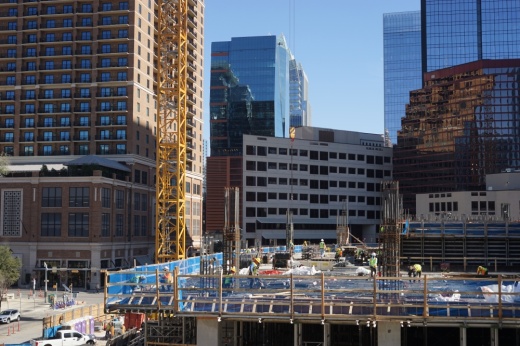The program aims to help fill thousands of skilled trades jobs with local talent as Austin widens I-35, expands the airport, renovates the convention center and adds a light rail to its transportation network.
The academy could operate similarly to the Art in Public Spaces program, which commissions local artists to create murals and other installations throughout the city.
“We're going to build the physical infrastructure that we determined we need for this community, [but] we don't have the human infrastructure in place,” Mayor Kirk Watson told Community Impact. “And that’s what this is about.”
The why
The Infrastructure Academy follows an October report from consulting firm CivicSol that found Austin will need to fill 10,000 infrastructure and mobility jobs per year for the next 17 years to realize its laundry list of capital projects. Watson said that means Austin will need to maintain its current workforce and add 4,000 new workers to it each year for nearly the next two decades.
The city’s infrastructure workforce is already made up of 222,000 workers, more than the local health care and manufacturing industries combined, Watson said.
Austin will also need to ramp up its recruiting efforts and improve coordination with existing organizations, such as Workforce Solutions Capital Area, Skillpoint Alliance and Austin Community College to get local workers trained and hired, the study found.
The impact
The boom in infrastructure and mobility jobs—some of which require training that can be completed in a matter of weeks—could transform Austin into a city that doesn’t require a college degree to be successful, Watson said.
Watson said a “key goal” of the Infrastructure Academy is to establish a new normal in which a high school graduate can go to trade school instead of a four-year university and thrive in Austin.
Creating that reality means starting the recruiting process for skilled trades jobs as early as seventh grade, said Sarah Garza, director of mobility industry partnerships at Workforce Solutions Capital Area.
“We know with the amount of workers that we're going to need for these projects, we can't just pull from the same well of talent; we're going to need to dig a little deeper,” Garza said.
Quote of note
“We never want to dismiss someone achieving their highest level of educational attainment,” said Tamara Atkinson, CEO of Workforce Solutions Capital Area. “But we also need to equally be sharing the narrative that people can, right out of high school, get to work and be learning, and in four years after their peers are graduating from college with debt, they can be earning $70,000 [a year] and have zero debt.”
Diving in deeper
Another key focus of the Infrastructure Academy is investing in and making affordable child care accessible, as it remains a barrier for parents, particularly women, looking to land an infrastructure job.
Women make up about 15% of Austin’s skilled trades workforce, Watson said, but it should be around 41% to be consistent with the general population of the city’s workforce.
Members of Go Austin/Vamos Austin, or GAVA, spoke during public comment March 7 demanding more action on affordable child care as Austin has seen a growing waitlist for child care subsidies that reached nearly 4,000 people in December.
The group urged City Council to invest $1.5 million for early childhood education and child care costs as part of the Infrastructure Academy.
“Since his first 100 days Mayor Watson has spoken broadly on record of his plans to support child care; however, to our knowledge, Item 21 is the first resolution to come forth from him that mentions child care,” GAVA said in a statement to Community Impact. “Since the proposed Academy will create increased demand on the existing child care system that is already overwhelmed and under-resourced, GAVA urged council to act now and amend the resolution to do more to build up early childhood solutions with dedicated funding to meet current child care needs and to better prepare for the child care needs of the 4,000 new Infrastructure Academy workers.”
What’s next
Austin leaders are working on finding a brick-and-mortar location for the Infrastructure Academy, which will be announced soon, officials said.





